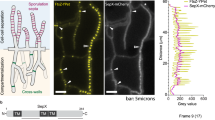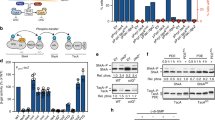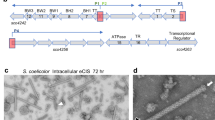Abstract
During development in the cellular slime mould Dictyostelium discoideum starved amoebae aggregate to form multicellular structures that display a simple antero-posterior pattern: pre-stalk cells occupy the front 20% of the aggregate, and prespore cells occupy the remainder1–4. We have attempted to elucidate the nature of the mechanism regulating the proportions of the two cell types1,5,6 by examining the factors that influence the pathway of differentiation of amoebae in vitro. Amoebae of D. discoideum strain V12 M2 form stalk cells efficiently in appropriate conditions and ‘sporogenous’ derivatives produce spores as well as stalk cells7,8. Mature spores are formed in a medium containing only cyclic AMP and salts9, whereas formation of stalk cells requires, in addition, a low molecular weight hydrophobic factor (DIF)7,10. Recent observations have led us to propose that DIF is a morphogen responsible for activating stalk cell differentiation5,11–13. Here we present evidence that ammonia is a second morphogen, that acts antagonistically to DIF, and that the choice of differentiation pathway is mediated by intracellular pH.
This is a preview of subscription content, access via your institution
Access options
Subscribe to this journal
Receive 51 print issues and online access
$199.00 per year
only $3.90 per issue
Buy this article
- Purchase on Springer Link
- Instant access to full article PDF
Prices may be subject to local taxes which are calculated during checkout
Similar content being viewed by others
References
MacWilliams, H. K. & Bonner, J. T. Differentiation 14, 1–22 (1979).
Raper, K. B. J. Elisha Mitchell scient. Soc. 56, 241–282 (1940).
Loomis, W. F. Dictyostelium discoideum: A Developmental System (Academic, New York, 1975).
Williams, K. L. et al. Differentiation 18, 1–63 (1981).
Gross, J. D. et al. Phil. Trans. R. Soc. B295, 497–508 (1981).
Morrissey, J. in Development of Dictyostelium (ed. Loomis, W. F.) (Academic, New York, in the press).
Town, C. D. et al. Nature 262, 717–719 (1976).
Kay, R. R. et al. Nature 271, 58–60 (1978).
Kay, R. R. Proc. natn. Acad. Sci. U.S.A. 79, 3228–3231 (1982).
Town, C. & Stanford, E. Proc. natn. Acad. Sci. U.S.A. 76, 308–312 (1979).
Kay, R. R. & Jermyn, K. A. Nature 303, 242–244 (1983).
Brookman, J. J. et al. Devl Biol. 91, 191–196 (1982).
Kopachik, W. et al. Cell (in the press).
White, G. J. & Sussman, M. Biochim. biophys. Acta 53, 285–293 (1961).
Schindler, J. & Sussman, M. J. molec. Biol. 116, 161–169 (1977).
Sussman, M. & Schindler, J. Differentiation 10, 1–5 (1978).
Hames, B. D. & Ashworth, J. M. Biochem. J. 142, 301–315 (1974).
Sternfeld, J. & David, C. N. J. Cell Sci. 38, 181–191 (1979).
Bradbury, J. M. thesis, Univ. London (1982).
Epel, D. et al. Devl Biol. 40, 245–255 (1974).
Vacquier, V. D. & Brandriff, B. Devl Biol. 47, 12–31 (1975).
Steinhardt, R. A. & Mazia, D. Nature 241, 400–401 (1973).
Winkler, M. M. & Grainger, J. L. Nature 273, 536–538 (1978).
Nuccitelli, R. & Deamer, D. W. (eds) Intracellular pH: Its Measurement Regulation and Utilization in Cellular Functions (Liss, New York, 1982).
West, I. C. & Mitchell, P. Biochem. J. 144, 87–90 (1974).
Murer, H. et al. Biochem. J. 154, 597–604 (1976).
Sachs, G. et al. J. biol. Chem. 251, 7690–7698 (1976).
Spanswick, R. M. A. Rev. Pl. Physiol. 32, 267–289 (1981).
Steinmetz, P. R. & Andersen, O. S. J. Membrane Biol. 65, 155–174 (1982).
Fingerle, J. & Gradmann, D. J. Membrane Biol. 68, 67–77 (1982).
Bowman, B. J. et al. Biochim. biophys. Acta 512, 13–28 (1978).
Scarborough, G. A. Biochemistry 19, 2925–2931 (1980).
Serrano, R. Eur. J. Biochem. 105, 419–424 (1980).
Vianello, A. & Macri, F. Planta 143, 51–57 (1978).
Gerson, D. F. et al. Science 216, 1009–1010 (1982).
Pouyssegur, J. et al. Proc. natn. Acad. Sci. U.S.A. 79, 3935–3939 (1982).
Moolenaar, W. et al. J. biol. Chem. 257, 8502–8506 (1982).
Schuldiner, S. & Rozengurt, E. Proc. natn. Acad. Sci. U.S.A. 79, 7778–7782 (1982).
Kay, R. R. & Trevan, D. J. J. Embryol. exp. Morph. 62, 369–378 (1981).
Yamasaki, E. & Ames, B. N. Proc. natn. Acad. Sci. U.S.A. 74, 3555–3559 (1977).
McIlvaine, T. C. J. biol. Chem. 49, 183–186 (1921).
Author information
Authors and Affiliations
Rights and permissions
About this article
Cite this article
Gross, J., Bradbury, J., Kay, R. et al. Intracellular pH and the control of cell differentiation in Dictyostelium discoideum. Nature 303, 244–245 (1983). https://doi.org/10.1038/303244a0
Received:
Accepted:
Issue Date:
DOI: https://doi.org/10.1038/303244a0
This article is cited by
-
Ammonia differentially suppresses the cAMP chemotaxis of anterior-like cells and prestalk cells indictyostelium discoideum
Journal of Biosciences (2001)
-
Dual role of cAMP duringDictyostelium development
Experientia (1995)
-
Patterning in the cellular slime moulds
Journal of Biosciences (1992)
-
The determination of spatial pattern inDictyostelium discoideum
Journal of Biosciences (1992)
-
Possible roles of cAMP and Ca2+ in the regulation of miracidial transformation inSchistosoma mansoni
Parasitology Research (1989)
Comments
By submitting a comment you agree to abide by our Terms and Community Guidelines. If you find something abusive or that does not comply with our terms or guidelines please flag it as inappropriate.



